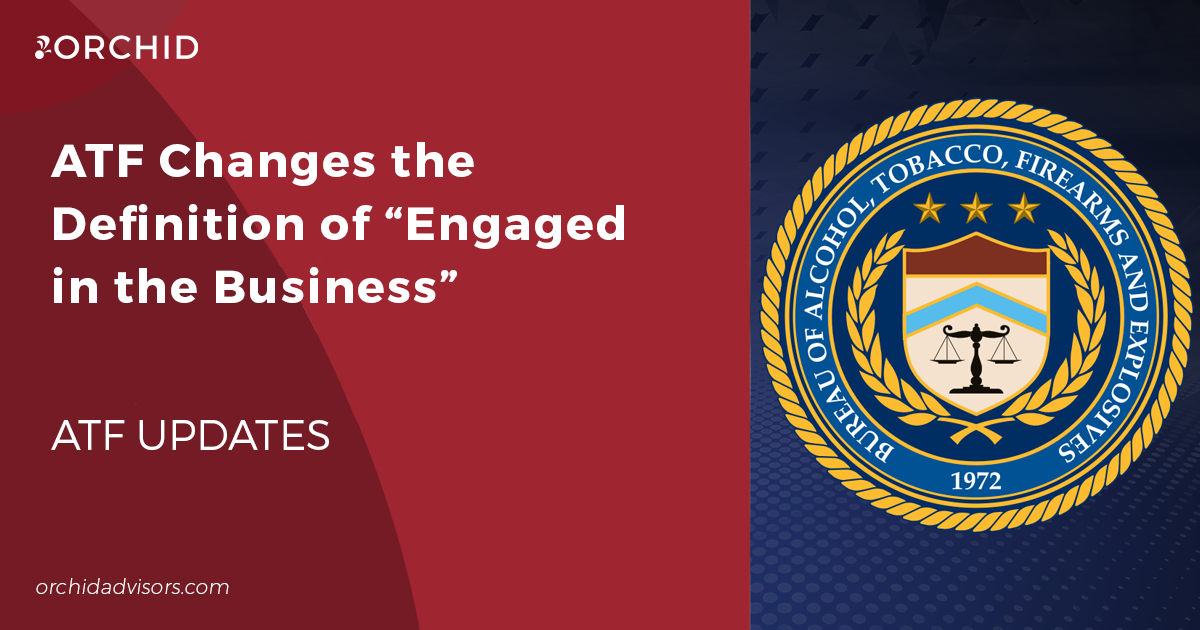 (Download)
One of the biggest undertakings of the firearms industry in the past 18 months has been waiting. Massive shifts in state legislation. Constitutional litigation. Interstate relocations. Product modifications. And then waiting.
Now, it’s time for us to take a deep breath and think about where we all are and do some prognosticating about where we’re all going. The reason we’re taking this breath is for the same reason long-range shooters learn to read the wind, and when the pattern is erratic, learn to utilize the lulls.
Let’s chat our way through a recap.
Early in 2013, first New York, then Connecticut, then, Maryland passed major gun control legislation. Colorado and Massachusetts passed important Bills. New Jersey passed some of a list of Bills. Other states passed what we could term “positive” legislation for the industry, including two states making state constitutional amendments enhancing the right to own firearms and the requirement that judges uses a “strict scrutiny” standard for evaluation of any legislation that seeks to limit that right.
Perhaps the easiest ways to understand what happened on the state level is to notice the Amicus Briefs filed in a lawsuit that sprang up in New York, namely, the New York Rifle and Pistol Association vs. Cuomo. “Amicus Briefs” are filed by “friends” of one party or the other. In this particular lawsuit, fully 22 States Attorney General filed a joint Amicus Brief against the NY legislation, while only nine filed a friends’ brief in support. While a lawsuit is not a sports match, it was a historic snapshot of state government trending.
When these cases in NY, CT, and MD started out, they were among some 250,000 plus cases pending at the District Court level. Now, the three cases are among only about 60,000 cases pending to Circuit Courts. Because these appeals are “as of right,” they were entitled to advance to request reversals of the District Court decisions. We should see appellate outcomes in early 2015.
The big question will be if any one or more of these three cases will be accepted for review by the US Supreme Court, where only about 75 cases are heard each year. While Circuit Courts can and do disagree with each other on significant aspects of the Second Amendment, a US Supreme Court decision would be national in impact.
Between now and then, we may see an easing in state legislation curtailing gun ownership until the US Supreme Court rules or declines to hear the cases, whichever is the final outcome. We could see the industry go from varying state or regional rulings to a single, national approach.
These lawsuits have yet to be noticed by mainstream media, in spite of their historic nature. This is not uncommon. The judicial branch tends to lack the elements that headline, and federal judges rarely to never appear on camera. While state bills can generate public anxiety that can create a near instant impetus for consumer activity, not so with lawsuits.
And, just in case you’re not in tune with these lawsuits, the essential, pending questions are whether the state can ban “assault weapons” and/or “large capacity magazines,” each of these definitions varying from one state to the other. The implications, if the US Supreme Court ultimately issues a ruling in 2015, could be akin to signaling yea or nay to those Members of Congress who favor revival of the 1994 Assault Weapons Ban.
Manufacturers and importers also seem to have run the length of interstate relocations of lines, expansions, and closures. From gun control to gun friendly, from higher to lower population densities, these moves represented a singular, significant economic event that it will warrant ongoing study. These events were costly and will take a period of years to measure.
And then there are consumers. Certainly, those who were already fans of the shooting sports or Second Amendment supporters, supported the industry from firearms to ranges. A new segment of consumer stole the headlines, namely women, representing not only purchasing power, but voices for self-defense.
Even though it seems quieter at the moment than it has seemed in about 18 months, is it truly quiet?
The answer is no.
What we’re now starting to see are headlines in smaller newspapers, in particular, are the voices of confusion over the implementation of the waves of 2013 and 2014 state legislation. The reading of these articles is in the smaller news outlets, in part, because we are talking about the few, isolated, new arrests.
Why do these cases matter so much to the firearms industry?
These are the cases that will define the details of the “assault weapons” statutes, including the features and accessories that will impact both sales on the ground in these states and the design modifications that will be necessary to continue to engage in commerce in those markets. So far, every case of which we are aware, involves pre-2013 firearms. In other words, we don’t believe, or at least haven’t readily seen multiple cases yet charging a defendant over possession of a post-legislation modification.
Second Amendment supporters have a tight and vast social media network, which improves our ability to monitor these reports. At least one organization is compiling research through freedom of information requests to compile an active database.
This kind of secondary wave of constitutional claims is normal in the current atmosphere. Historically, with notable examples in the early 1900s, the mid-1950s, and again in the 1970s, we have seen the same pattern of tidal waves of litigation leading to major federal constitutional lawsuit, while, with a slight delay, there were dozens into hundreds of smaller cases in smaller courtrooms. The large-scale litigation functions as a kind of statute, while the smaller, individual cases function like implementing regulations.
So stay tuned. What may appear a lull to you, may not be to an F-Class shooter who knows that wind is not just that which you see in the air, but also that which you can read rising up off the ground.
(Download)
One of the biggest undertakings of the firearms industry in the past 18 months has been waiting. Massive shifts in state legislation. Constitutional litigation. Interstate relocations. Product modifications. And then waiting.
Now, it’s time for us to take a deep breath and think about where we all are and do some prognosticating about where we’re all going. The reason we’re taking this breath is for the same reason long-range shooters learn to read the wind, and when the pattern is erratic, learn to utilize the lulls.
Let’s chat our way through a recap.
Early in 2013, first New York, then Connecticut, then, Maryland passed major gun control legislation. Colorado and Massachusetts passed important Bills. New Jersey passed some of a list of Bills. Other states passed what we could term “positive” legislation for the industry, including two states making state constitutional amendments enhancing the right to own firearms and the requirement that judges uses a “strict scrutiny” standard for evaluation of any legislation that seeks to limit that right.
Perhaps the easiest ways to understand what happened on the state level is to notice the Amicus Briefs filed in a lawsuit that sprang up in New York, namely, the New York Rifle and Pistol Association vs. Cuomo. “Amicus Briefs” are filed by “friends” of one party or the other. In this particular lawsuit, fully 22 States Attorney General filed a joint Amicus Brief against the NY legislation, while only nine filed a friends’ brief in support. While a lawsuit is not a sports match, it was a historic snapshot of state government trending.
When these cases in NY, CT, and MD started out, they were among some 250,000 plus cases pending at the District Court level. Now, the three cases are among only about 60,000 cases pending to Circuit Courts. Because these appeals are “as of right,” they were entitled to advance to request reversals of the District Court decisions. We should see appellate outcomes in early 2015.
The big question will be if any one or more of these three cases will be accepted for review by the US Supreme Court, where only about 75 cases are heard each year. While Circuit Courts can and do disagree with each other on significant aspects of the Second Amendment, a US Supreme Court decision would be national in impact.
Between now and then, we may see an easing in state legislation curtailing gun ownership until the US Supreme Court rules or declines to hear the cases, whichever is the final outcome. We could see the industry go from varying state or regional rulings to a single, national approach.
These lawsuits have yet to be noticed by mainstream media, in spite of their historic nature. This is not uncommon. The judicial branch tends to lack the elements that headline, and federal judges rarely to never appear on camera. While state bills can generate public anxiety that can create a near instant impetus for consumer activity, not so with lawsuits.
And, just in case you’re not in tune with these lawsuits, the essential, pending questions are whether the state can ban “assault weapons” and/or “large capacity magazines,” each of these definitions varying from one state to the other. The implications, if the US Supreme Court ultimately issues a ruling in 2015, could be akin to signaling yea or nay to those Members of Congress who favor revival of the 1994 Assault Weapons Ban.
Manufacturers and importers also seem to have run the length of interstate relocations of lines, expansions, and closures. From gun control to gun friendly, from higher to lower population densities, these moves represented a singular, significant economic event that it will warrant ongoing study. These events were costly and will take a period of years to measure.
And then there are consumers. Certainly, those who were already fans of the shooting sports or Second Amendment supporters, supported the industry from firearms to ranges. A new segment of consumer stole the headlines, namely women, representing not only purchasing power, but voices for self-defense.
Even though it seems quieter at the moment than it has seemed in about 18 months, is it truly quiet?
The answer is no.
What we’re now starting to see are headlines in smaller newspapers, in particular, are the voices of confusion over the implementation of the waves of 2013 and 2014 state legislation. The reading of these articles is in the smaller news outlets, in part, because we are talking about the few, isolated, new arrests.
Why do these cases matter so much to the firearms industry?
These are the cases that will define the details of the “assault weapons” statutes, including the features and accessories that will impact both sales on the ground in these states and the design modifications that will be necessary to continue to engage in commerce in those markets. So far, every case of which we are aware, involves pre-2013 firearms. In other words, we don’t believe, or at least haven’t readily seen multiple cases yet charging a defendant over possession of a post-legislation modification.
Second Amendment supporters have a tight and vast social media network, which improves our ability to monitor these reports. At least one organization is compiling research through freedom of information requests to compile an active database.
This kind of secondary wave of constitutional claims is normal in the current atmosphere. Historically, with notable examples in the early 1900s, the mid-1950s, and again in the 1970s, we have seen the same pattern of tidal waves of litigation leading to major federal constitutional lawsuit, while, with a slight delay, there were dozens into hundreds of smaller cases in smaller courtrooms. The large-scale litigation functions as a kind of statute, while the smaller, individual cases function like implementing regulations.
So stay tuned. What may appear a lull to you, may not be to an F-Class shooter who knows that wind is not just that which you see in the air, but also that which you can read rising up off the ground.The ATF Changes Definition of “Engaged in the Business”
The final version of ATF Rule 2022R-17 has been submitted to the Federal Register and will go into effect 30 days after the date...






0 Comments